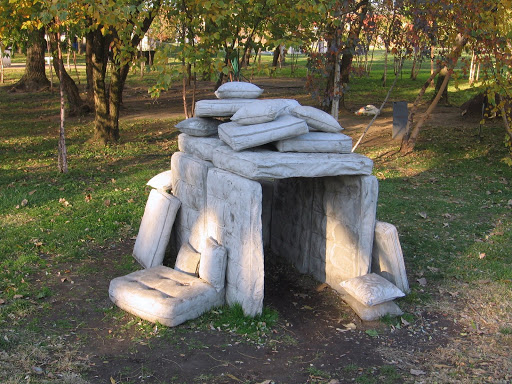A scenic half-hour trainride up the edge of the Hudson River leads to a picturesque village known as Tarrytown. In 1996, North Tarrytown officially renamed itself Sleepy Hollow, which is a. a better name, and b. a cunning ploy to cash in on the notoriety from Washington Irving's famous short story, "The Legend of Sleepy Hollow," which since its publication in 1820 has been both Disney-fied and Burton-ized.
The peaceful Main Street which runs through the center of town is dotted with antique and curio shops, and the majestic Tarrytown Music Hall. Venturing north along Route 9, however, is to follow the hectic hoofsteps of Ichabod Crane's last ride. Crane first encounters the Headless Horseman at the very spot where the Revolutionary spy Major John Andre was captured, thwarting the plot to turn West Point over to the British. Today a monument marks this site on the edge of Patriots Park, also described in the story.
The wooden bridge spanning the Pocantico River on which Crane meets his fate no longer exists, nor does the schoolhouse where he was supposed to have taught. However a mockup of the "Headless Horseman" bridge was constructed within the grounds of Sleepy Hollow Cemetery, which agreeably looks the part. The cemetery, meanwhile, is the resting place for Washington Irving and his family, as well as such luminaries as Andrew Carnegie, Samuel Gompers, Walter Chrysler, and Leona Helmsley. The Sleepy Hollow Cemetery itself was not in existence at the time of the story's publication, but the adjoining Old Dutch Church Burying Grounds was, and reportedly contains the remains of those who served as the inspiration for the characters of Katrina Van Tassel and Brom Bones.

Tarrytown, the setting for "The Legend of Sleepy Hollow."

The Tarrytown Music Hall. At the time I passed by, Olivia Newton-John was next scheduled performer.

Curios in the window of a barber shop.

Prior to 1996 this sign would have read "Village of North Tarrytown."

A memorial to the capture of Major Andre, who was hanged as a spy in 1780.

Patriots Park, the spot where Ichabod Crane first encounters the Headless Horseman.


The Philipsburg grist mill.

Philipsburg Manor, now a non-profit museum.


The original bridge on which Ichabod Crane faces the Headless Horsemen would have crossed the Pocantico River at just about this spot.

The Old Dutch Church Burying Grounds, where a terrified Ichabod Crane flees from his spectral pursuer.

Washington Irving's family plot.




The Hudson River in the distance.

The imposing grave of Charles H. Delavan, whoever he was.




An unfortunate surname.

Samuel Gompers, the influential labor union leader.

Andrew Carnegie's surprisingly modest grave marker.


Memorial to "Baby Girl Cleveland," dated 1970.


A faux-Headless Horsemen bridge erected upstream from the original location to give visitors with high expectations something to photograph.


The last view Ichabod Crane has before getting fatally bepumpkined.


Violators will be beheaded.
22 November 2011
Sleepy Hollow
17 November 2011
Umberto Eco
Umberto Eco at B&N Union Square to discuss his recently published novel The Prague Cemetery with Antonio Monda.

Eco on conspiracies: "I'm not fascinated by plots. I'm fascinated by the stupidity of those who believe in plots."

He also made a distinction between love and hate. To paraphrase: Love is selective. 'I love you. I want you to love me. I don't want you to love anyone else.' But hate is general. It is social. It brings people together.
I would comment more on their conversation but both speakers' English was difficult to understand from a distance and Eco often forgot to speak into his microphone. It looked like they were having a very erudite discussion though.
13 November 2011
The Impossible Girl
The Impossible Girl herself, Kim Boekbinder, struck again at one of the most unique lofts in Brooklyn. Known as the House of Collection, the space is filled to the rafters with two decades worth of dusty acquisitions—vintage typewriters, cameras, clocks, cash registers, fossils, hats, nets, farm equipment, stuffed animals, and various other artifacts of yore. Nothing less than a museum of Americana.
As if to set the tone of the evening, I walked in on a lively circle discussion of lesbianism in Archie comics. Three-fourths of a whiskey sour later, the Girl emerged impossibly from a hidden alcove, a blur of aladdin sane peacock plumage and glitter. She mounted a corner platform framed by ferns and fronds and began to craft swirling soundscapes from guitar-powered strands of spun silk, rattling chains, birdcalls, and squawking rubber lizards, even at one point incorporating the roar of the J train passing outside the window. These shimmering loops she harnessed into songs about gypsies, nuclear physics, avocados, and fucking. She even boldly improvised two new songs on the spot, one a cautionary tale about falling in love with someone from distant Australia, the other an ode to cephalopods. (The word "cephalopod" has always sounded to me like a flavor of exotic tea.) For an encore she returned wielding a banjolele (or "ukelanjo," if you're left-handed) for some heartfelt warbles sans gadgetry. I was foolish enough not to bring along my camera and had to make due with the one in my cellphone, hence the unfortunate grainy quality of the accompanying photos. Still, better than nothing.
On the way home I passed a didgeridoo busker on a subway platform, which seemed so uncannily appropriate in tone that I wondered how his presence had been arranged as a fanciful nightcap just for my benefit. A parting reminder never to underestimate the powers of the Impossible Girl.


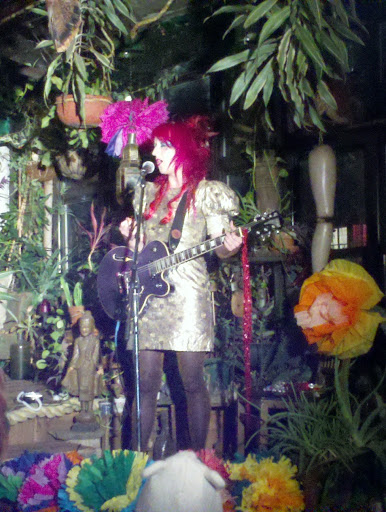
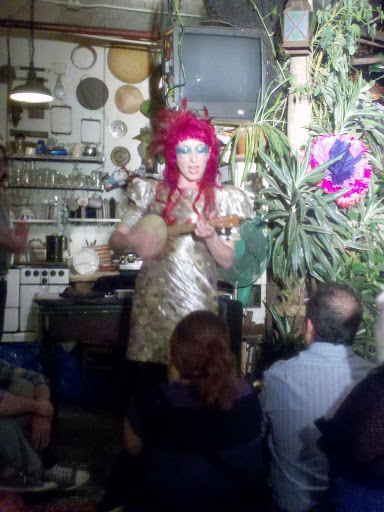

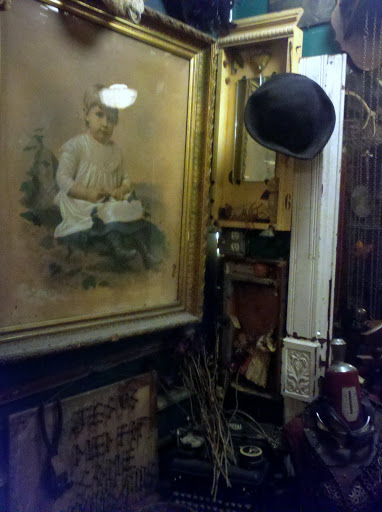
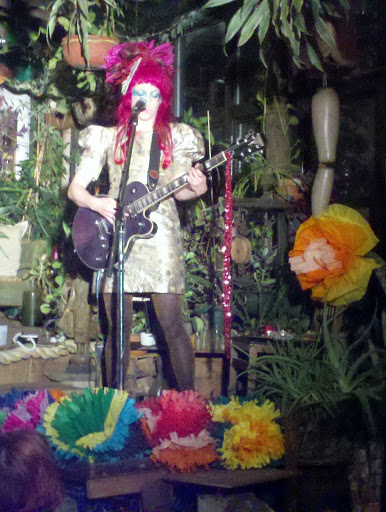



06 November 2011
Socrates Sculpture Park
In an unassuming and deceptively industrial-looking corner of Long Island City lies the Socrates Sculpture Park. The park opened in 1986 on what was previously landfill to serve as an outdoor museum for artists to exhibit multimedia installations and to function as a neighborhood park with scenic views of Roosevelt Island and eastern Manhattan. Weekends are devoted to the Makers Market, an open air marketplace of design and craft. The space also hosts creative workshops, kiteflying, and various other community-based programs throughout the week. A charming spot for a fatal sip of hemlock.














